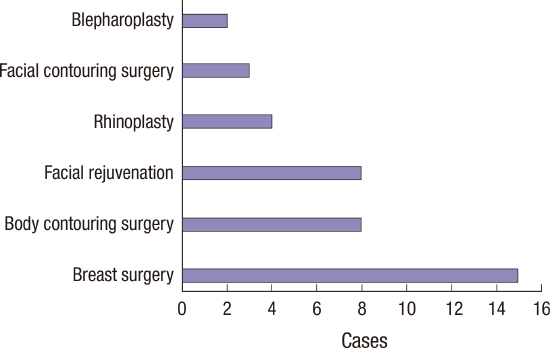1. Bratzler DW, Houck PM; Surgical Infection Prevention Guideline Writers Workgroup. Antimicrobial prophylaxis for surgery: an advisory statement from the National Surgical Infection Prevention Project. Am J Surg. 2005; 189:395–404.
2. Horan TC, Gaynes RP, Martone WJ, Jarvis WR, Emori TG. CDC definitions of nosocomial surgical site infections, 1992: a modification of CDC definitions of surgical wound infections. Infect Control Hosp Epidemiol. 1992; 13:606–608.
3. Emori TG, Gaynes RP. An overview of nosocomial infections, including the role of the microbiology laboratory. Clin Microbiol Rev. 1993; 6:428–442.
4. Bratzler DW, Dellinger EP, Olsen KM, Perl TM, Auwaerter PG, Bolon MK, Fish DN, Napolitano LM, Sawyer RG, Slain D, et al. Clinical practice guidelines for antimicrobial prophylaxis in surgery. Surg Infect (Larchmt). 2013; 14:73–156.
5. Lyden JR, Dellinger EP. Surgical site infections. Hosp Med Clin. 2016; 5:319–333.
6. Cheadle WG. Risk factors for surgical site infection. Surg Infect (Larchmt). 2006; 7:Suppl 1. S7–11.
7. Ahmadi AH, Cohen BE, Shayani P. A prospective study of antibiotic efficacy in preventing infection in reduction mammaplasty. Plast Reconstr Surg. 2005; 116:126–131.
8. Peled IJ, Dvir G, Berger J, Ramon I, Ullmann Y, Nachlieli T. Prophylactic antibiotics in aesthetic and reconstructive surgery. Aesthetic Plast Surg. 2000; 24:299–302.
9. LeRoy JL Jr, Rees TD, Nolan WB 3rd. Infections requiring hospital readmission following face lift surgery: incidence, treatment, and sequelae. Plast Reconstr Surg. 1994; 93:533–536.
10. Meyers AD. Prophylactic antibiotics in nasal surgery. Arch Otolaryngol Head Neck Surg. 1990; 116:1125–1126.
11. Choi JH. Legal aspects on nosocomial infection. Korean J Med. 2009; 76:Suppl 2. S286–9.
12. Kompatscher P, von Planta A, Spicher I, Seifert B, Vetter S, Minder J, Beer GM. Comparison of the incidence and predicted risk of early surgical site infections after breast reduction. Aesthetic Plast Surg. 2003; 27:308–314.
13. Tejirian T, DiFronzo LA, Haigh PI. Antibiotic prophylaxis for preventing wound infection after breast surgery: a systematic review and metaanalysis. J Am Coll Surg. 2006; 203:729–734.
14. Mioton LM, Jordan SW, Hanwright PJ, Bilimoria KY, Kim JY. The relationship between preoperative wound classification and postoperative infection: a multi-institutional analysis of 15,289 patients. Arch Plast Surg. 2013; 40:522–529.
15. Thomassin JM, Bardot J, Radulesco T. Rhinoplasty: medicolegal issues. Ann Chir Plast Esthet. 2014; 59:592–595.
16. Reisman NR. Medicolegal issues in breast reduction. Clin Plast Surg. 2016; 43:441–444.
17. White AA, Pichert JW, Bledsoe SH, Irwin C, Entman SS. Cause and effect analysis of closed claims in obstetrics and gynecology. Obstet Gynecol. 2005; 105:1031–1038.
18. Ward CJ. Analysis of 500 obstetric and gynecologic malpractice claims: causes and prevention. Am J Obstet Gynecol. 1991; 165:298–304.
19. Gravante G, Caruso R, Araco A, Cervelli V. Infections after plastic procedures: incidences, etiologies, risk factors, and antibiotic prophylaxis. Aesthetic Plast Surg. 2008; 32:243–251.
20. Gorney M. Avoiding litigation in breast modification. Plast Reconstr Surg. 2011; 127:2113–2115.
22. Recht A, Come SE, Henderson IC, Gelman RS, Silver B, Hayes DF, Shulman LN, Harris JR. The sequencing of chemotherapy and radiation therapy after conservative surgery for early-stage breast cancer. N Engl J Med. 1996; 334:1356–1361.
23. Bratzler DW, Dellinger EP, Olsen KM, Perl TM, Auwaerter PG, Bolon MK, Fish DN, Napolitano LM, Sawyer RG, Slain D, et al. Clinical practice guidelines for antimicrobial prophylaxis in surgery. Am J Health Syst Pharm. 2013; 70:195–283.
24. Pittet B, Montandon D, Pittet D. Infection in breast implants. Lancet Infect Dis. 2005; 5:94–106.
25. Gabriel SE, Woods JE, O’Fallon WM, Beard CM, Kurland LT, Melton LJ 3rd. Complications leading to surgery after breast implantation. N Engl J Med. 1997; 336:677–682.
27. Tablan OC, Anderson LJ, Besser R, Bridges C, Hajjeh R. CDC; Healthcare Infection Control Practices Advisory Committee. Guidelines for preventing health-care--associated pneumonia, 2003: recommendations of CDC and the Healthcare Infection Control Practices Advisory Committee. MMWR Recomm Rep. 2004; 53:1–36.
28. Mojon P. Oral health and respiratory infection. J Can Dent Assoc. 2002; 68:340–345.
29. Kluytmans JA, Wertheim HF. Nasal carriage of Staphylococcus aureus and prevention of nosocomial infections. Infection. 2005; 33:3–8.






 PDF
PDF ePub
ePub Citation
Citation Print
Print









 XML Download
XML Download